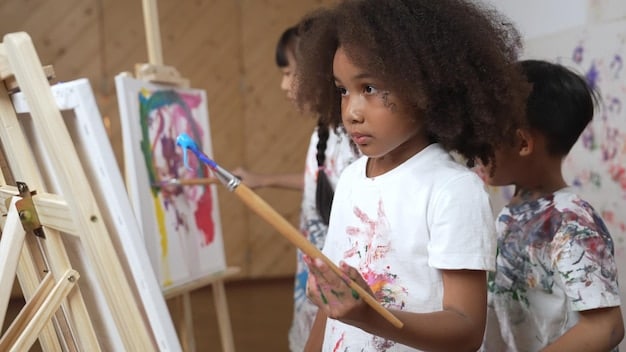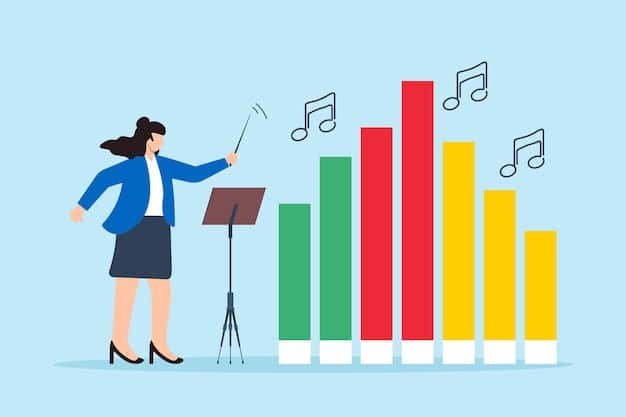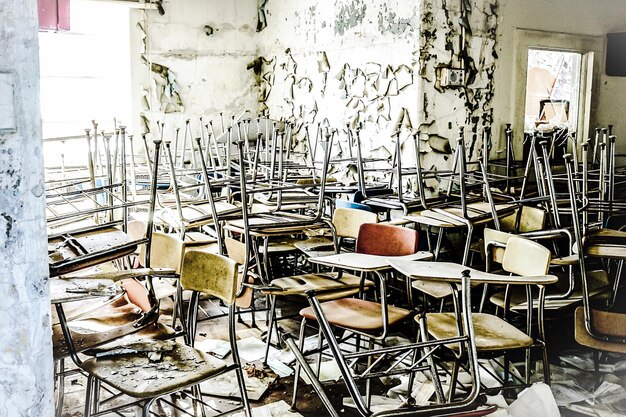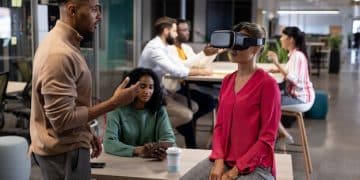Comprehensive Arts Education: Percentage in US Schools & Why It Matters

Comprehensive arts education programs are offered in approximately 20% to 40% of US schools, a range reflecting variations in funding, location, and school priorities. This article explores the current status, benefits, challenges, and future directions of arts education across the United States.
What percentage of US schools offer comprehensive arts education programs? The answer isn’t as straightforward as we might hope. While the transformative power of arts education is widely recognized, its accessibility across the United States varies significantly. Let’s delve into the current landscape and explore its importance.
Understanding Comprehensive Arts Education in US Schools
Comprehensive arts education encompasses a wide range of artistic disciplines, including visual arts, music, theater, and dance. It’s more than just an elective; it’s an integrated part of the curriculum that aims to foster creativity, critical thinking, and cultural awareness.
But how widespread is this ideal in US schools? The reality is a mixed bag, with some schools fully embracing arts education and others struggling to provide even the basics.
Defining Comprehensive Arts Education
A truly comprehensive program goes beyond simply offering art classes. It involves:
- Integration of arts across the curriculum, connecting artistic concepts with other subjects.
- Qualified arts educators who are trained in their respective disciplines.
- Adequate funding and resources, including materials, equipment, and space.
- Opportunities for students to engage with the arts both in and out of the classroom, such as field trips to museums and performances.
Current Status of Arts Education
Numerous studies and reports have shed light on the availability of arts education in US schools. While specific numbers vary depending on the data source and methodology, a few key trends emerge:
- Access to arts education is not equitable, with disparities based on socioeconomic status, race, and geographic location.
- Many schools lack the resources to offer comprehensive programs, leading to a fragmented and uneven landscape.
- Despite the challenges, there are shining examples of schools and districts that have prioritized arts education and achieved impressive results.

In conclusion, achieving a truly comprehensive arts education across all US schools requires a concerted effort to address funding gaps, ensure equitable access, and prioritize the arts as an essential component of every student’s learning experience.
The Benefits of Arts Education
The benefits of a comprehensive arts education extend far beyond the development of artistic skills. Engaging with the arts can have a profound impact on students’ academic performance, social-emotional development, and overall well-being.
Let’s take a closer look at the various ways in which arts education can contribute to a well-rounded education.
Academic Achievement
Studies have shown that students who participate in arts education programs tend to perform better in other academic subjects. The arts can enhance:
- Critical thinking and problem-solving skills, as students learn to analyze and interpret complex concepts.
- Communication skills, as students learn to express themselves effectively through various artistic mediums.
- Creativity and innovation, as students are encouraged to think outside the box and develop original ideas.
Social-Emotional Development
Arts education can also play a crucial role in fostering students’ social-emotional development. Through the arts, students can:
- Develop empathy and understanding, as they explore diverse perspectives and cultures.
- Build self-confidence and self-esteem, as they gain recognition for their artistic achievements.
- Learn to collaborate and work effectively in teams, as they participate in group projects and performances.
Community Engagement
Arts education can also strengthen the connection between schools and their communities. Arts programs often involve:
- Partnerships with local artists and arts organizations.
- Community performances and exhibitions that showcase student work.
- Opportunities for students to engage with the arts outside of the school setting.
Ultimately, the benefits of arts education are multifaceted and far-reaching, contributing to students’ academic success, social-emotional growth, and community engagement. By prioritizing arts education, schools can empower students to reach their full potential and become active participants in a vibrant and creative society.
Challenges in Implementing Arts Education Programs
Despite the well-documented benefits of arts education, numerous challenges hinder its widespread implementation in US schools. These challenges range from funding constraints to curriculum pressures, impacting schools’ ability to offer comprehensive arts programs.
Understanding these obstacles is the first step towards finding solutions and ensuring that all students have access to quality arts education.
Funding Constraints
One of the most significant challenges is the lack of adequate funding for arts education. Budget cuts often target arts programs, leading to:
- Reduced staffing, with fewer arts teachers and specialists.
- Limited resources, such as materials, equipment, and space.
- Fewer opportunities for students to participate in arts activities.
Curriculum Pressures
The emphasis on standardized testing and core subjects can also squeeze out arts education. Schools may feel pressure to:
- Allocate more time and resources to subjects that are tested, such as math and reading.
- Narrow the curriculum, focusing on specific skills and knowledge at the expense of creativity and exploration.
- Reduce or eliminate arts classes in order to meet testing requirements.
Teacher Training and Support
Another challenge is the lack of adequate training and support for arts educators. Many teachers:
- Lack specialized training in their respective artistic disciplines.
- Feel isolated and unsupported, with limited opportunities for professional development and collaboration.
- Struggle to integrate the arts into other subjects due to a lack of resources and training.

Overcoming these challenges requires a multi-pronged approach that includes increased funding, curriculum reform, and improved teacher training and support. By addressing these obstacles, we can ensure that all students have the opportunity to benefit from the transformative power of arts education.
Successful Arts Education Models
Despite the challenges, there are numerous examples of schools and districts that have successfully implemented comprehensive arts education programs. These models offer valuable insights and inspiration for others looking to enhance their own arts offerings.
Analyzing these success stories can help identify key strategies and best practices that can be adapted to different contexts and settings.
The Turnaround Arts Initiative
The Turnaround Arts initiative, a program of the John F. Kennedy Center for the Performing Arts, works with low-performing schools to transform their cultures and improve student outcomes through arts education. The program provides:
- Intensive arts integration training for teachers.
- Partnerships with local artists and arts organizations.
- Access to high-quality arts resources and materials.
Arts Integration Strategies
Many schools have found success by integrating the arts into other subjects. This approach can involve:
- Using visual arts to teach math concepts.
- Incorporating music into history lessons.
- Using theater to explore literature.
Community Partnerships
Strong community partnerships can also play a crucial role in supporting arts education. Schools can partner with:
- Local museums and galleries to provide field trips and workshops.
- Professional artists and musicians to offer residencies and performances.
- Community organizations to provide funding and resources for arts programs.
The success of these models demonstrates that with dedication, creativity, and community support, it is possible to provide all students with a rich and meaningful arts education. By learning from these examples, schools can develop their own innovative approaches to arts integration and ensure that the arts remain a vital part of the educational experience.
Advocacy and Policy for Arts Education
Advocacy and policy play a crucial role in ensuring that all students have access to quality arts education. By raising awareness and supporting policies that prioritize the arts, we can create a more equitable and vibrant educational landscape.
Let’s examine the various ways in which advocacy and policy can contribute to the growth and sustainability of arts education programs.
National and Local Advocacy Organizations
Numerous organizations are dedicated to advocating for arts education at the national and local levels. These groups:
- Conduct research and disseminate information about the benefits of arts education.
- Lobby policymakers to support arts-friendly legislation.
- Provide resources and training for arts educators and advocates.
Policy Initiatives
Various policy initiatives can support arts education, including:
- Mandating arts education in state standards.
- Providing funding for arts education programs.
- Establishing arts education specialist positions in schools and districts.
Engaging Stakeholders
Effective advocacy also involves engaging a wide range of stakeholders, including:
- Parents and community members who can voice their support for arts education.
- School administrators and board members who make decisions about curriculum and budget.
- Policymakers who can enact legislation that supports the arts.
Through collective action and strategic advocacy, we can create a policy environment that values and supports arts education, ensuring that all students have the opportunity to benefit from its transformative power. By working together, we can build a future where the arts are recognized as an essential component of a well-rounded education.
The Future of Arts Education in the US
The future of arts education in the US hinges on continued advocacy, innovative approaches, and a commitment to equity. As the educational landscape evolves, it is imperative that the arts remain a central component of a well-rounded education.
Let’s explore some of the key trends and opportunities that will shape the future of arts education in the years to come.
Technology and the Arts
Technology is playing an increasingly important role in arts education, opening up new possibilities for:
- Digital art creation and collaboration.
- Virtual museum tours and online performances.
- Interactive learning experiences that engage students in new ways.
Culturally Responsive Arts Education
There is a growing emphasis on culturally responsive arts education, which seeks to:
- Recognize and celebrate the diverse cultural backgrounds of students.
- Incorporate culturally relevant content and pedagogy into arts instruction.
- Empower students to express themselves through art in ways that are meaningful to them.
Social Justice and the Arts
The arts are also being used as a tool for social justice, enabling students to:
- Explore critical issues and challenge social norms.
- Raise awareness about social inequalities and injustices.
- Advocate for change and create a more equitable world.
In conclusion, the future of arts education in the US is bright, with exciting opportunities to leverage technology, embrace cultural diversity, and promote social justice. By embracing these trends and continuing to advocate for the arts, we can ensure that future generations of students have access to a rich and transformative arts education that prepares them to thrive in a rapidly changing world.
| Key Point | Brief Description |
|---|---|
| 🎨 Current Percentage | Approximately 20-40% of US schools offer comprehensive arts education. |
| 📚 Academic Benefits | Arts education enhances critical thinking, communication, and creativity. |
| 💰 Funding Challenges | Budget cuts often reduce arts staffing and resources in schools. |
| 🤝 Community Support | Partnerships with local artists and organizations can bolster arts programs. |
Frequently Asked Questions (FAQ)
▼
A comprehensive program integrates visual arts, music, theater, and dance, with qualified educators and adequate resources. It also combines the arts across the curriculum, connecting them to other subjects.
▼
Arts education fosters creativity, critical thinking, and cultural awareness. It enhances academic performance, social-emotional development, as well as overall well-being. It also builds community engagement.
▼
The main difficulties include funding constraints, curriculum pressures, along with a need for better teacher training and support. Also, the emphasis on standardized testing can squeeze the arts.
▼
Schools can integrate arts through initiatives like Turnaround Arts, using arts integration strategies, and forming community partnerships with local museums and artists to provide resources for programs.
▼
Advocacy and policy-making are crucial for supporting arts education. They raise awareness, support policies, and get more stakeholders involved. Groups lobby policymakers to support arts-friendly laws.
Conclusion
In conclusion, while the percentage of US schools offering comprehensive arts education programs varies, the benefits are clear and the need is pressing. By addressing the challenges and embracing innovative approaches, we can ensure that all students have access to the transformative power of the arts.





